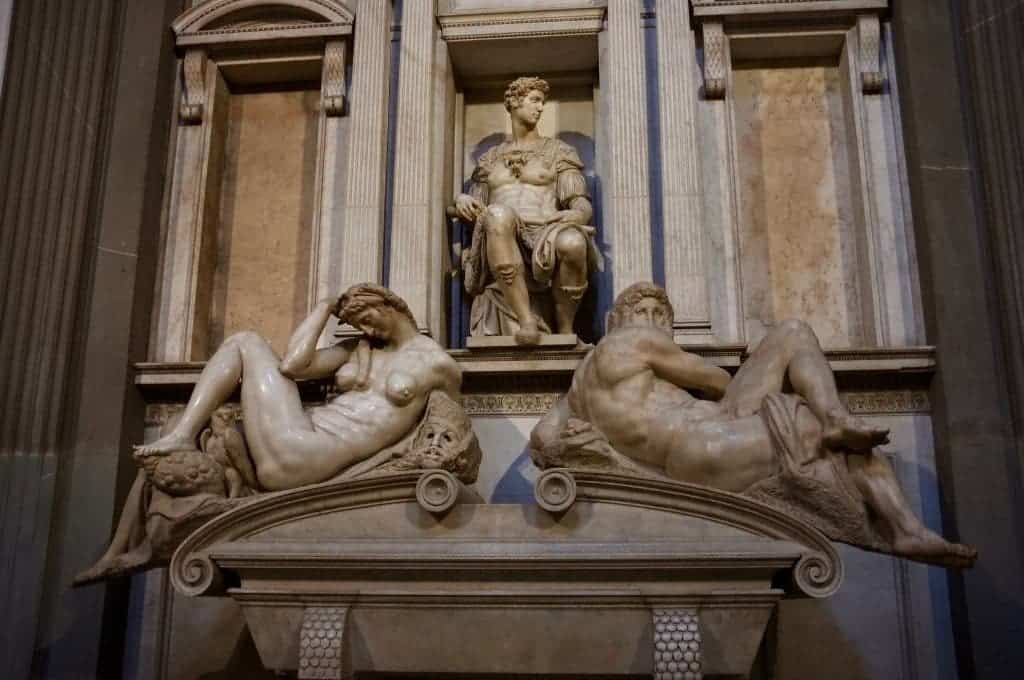
Whilst some of Michelangelo’s most famous marble sculptures, such as the exquisite David housed at the Galleria dell’Accademia in Florence and Pietà found in St. Peter’s Basilica in Vatican City, have been restored and preserved across the centuries, the same can’t be said about all the master’s great works.
After years of gathering grime that blemished Michelangelo’s marble statues in the Medici Chapel at the Basilica of San Lorenzo, Florence, art restorationists finally embarked on a delicate cleanup process. To this aim, the team employed an innovative method whereby specialized strains of bacteria were set loose to feed on the grime, restoring the luster of the marble molded by the maestro.
The tiniest art restorers in the world
Experts at Italy’s National Research Council had been restoring the sarcophaguses at the final resting place of the Medicis for nearly a decade. After years of painstaking and careful work, most of the blemishes on the artwork were safely removed — all but a few stubborn stains that didn’t seem to respond to conventional restoration methods.
The mess is attributed to Alessandro Medici, a former ruler of Florence who was assassinated in 1537 and his body was buried in his family’s chapel without being properly eviscerated. Over the centuries, compounds from Alessandro’s remains seeped into the marble of some of Michelangelo’s statues in the chapel, leading to deep stains that no known cleaning product could remove.
Ultimately, it was decided to employ microbes to good purpose, essentially turning the marble decorations into huge petri dishes. But first, they had to pick the right strains.
Biologist Anna Rosa Sprocati evaluated a catalog of over 1,000 strains. It was of the utmost importance that she selected the right bacteria for the job. For instance, some strains ate the grime — but also ate the marble of Michelangelo’s masterpieces. One wrong move and the restoration process could have turned into a disaster.
Ultimately, Sprocati settled for a shortlist of eight candidates, which she tested on a sample section behind the altar of the chapel. One of the bacteria called Serratia ficaria SH7 was particularly voracious — it ate oils, glue, and all of Alessandro’s phosphates, leaving Michelangelo’s marble sparkling white. The bacterium is non-hazardous to human health and doesn’t leave spores.
The bacteria was first used to clean the marble in the tomb of Giuliano di Lorenzo, Duke of Nemours, which is graced by the personification of Night and Day. Previously, Night’s hairs and ears were covered in black grime, which was successfully cleared away by two different strains Pseudomonas stutzeri CONC11, a bacterium isolated from the waste of a tannery near Naples, and Rhodococcus sp. ZCONT, a bacterium collected from soil contaminated with diesel in Caserta. Night’s face was treated with a stabilizer often found in toothpaste and cosmetics derived from Xanthomonas campestris bacteria.
Then work suddenly stopped because of COVID, resuming sometime mid-October 2020. Sprocati went back at it, spreading gels with the SH7 bacteria on the grimy sarcophagus of Lorenzo di Piero, Duke of Urbino, the father of the assassinated Alessandro.
A stain on the family name

All of these now squeaky clean masterpieces were commissioned by Pope Leo X, the first Medici pope, also known as Giovanni di Lorenzo de Medici, who desired a marvelous new sacristy as the final resting place for his noble family. Of course, they selected Michelangelo, the greatest artist of his time and a protege of the Medici family since he was a teenage boy.
After Leo X suddenly died of pneumonia, Michelangelo continued work on the marvelous mausoleum until 1527, the date Rome was sacked by the mutinous troops of Charles V, Holy Roman Emperor. Seeking to seize the opportunity, Florentines staged a coup to overthrow the Medicis and instate a Republic. Michelangelo supported this initiative that saw Alessandro, among many other Medicis, ousted from the city.
Alessandro was rough and uncultured, a lover of sensual pleasures who enriched himself personally through taxes and duties and was determined to make his authority absolute beyond all question. Many saw him as a tyrant. According to various historical sources, Michelangelo simply couldn’t stand Alessandro.
Michelangelo didn’t pick the winning side though, and it wasn’t long before the Medicis were back in town. In 1531, Pope Clement VII, another Medici pope (this is the kind of tremendous influence this banking family could command!), pardoned the exiled Michelangelo, who hastily went back to work to complete the family chapel. But by that time, Alessandro had become Duke of Florence. Michelangelo couldn’t sit in the same town as Alessandro, let alone in the same room, so it was time for the great Renaissance artist to flee once more.
In 1537, the loathsome Alessandro was murdered by a relative. His body was rolled up in a carpet and dropped into a sarcophagus without many honors. This time, when Michelangelo returned, he finished the job at the chapel. But even centuries later, Alessandro would stain his family’s name — quite literally.
Fortunately, some very hungry bacteria helped restorers finish the chapel’s much-needed cleanup. Tourists can now admire some of Michelangelo’s finest works in new light, as the chapel has been reopened to visitors.
This isn’t the first time microbes were used for art restoration. Sulphur-eating strains were used to clean black crusts from the Milan Cathedral. Bacteria were also used to clean a fresco on a cathedral dome in Pisa and a cemetery close to the Leaning Tower.


